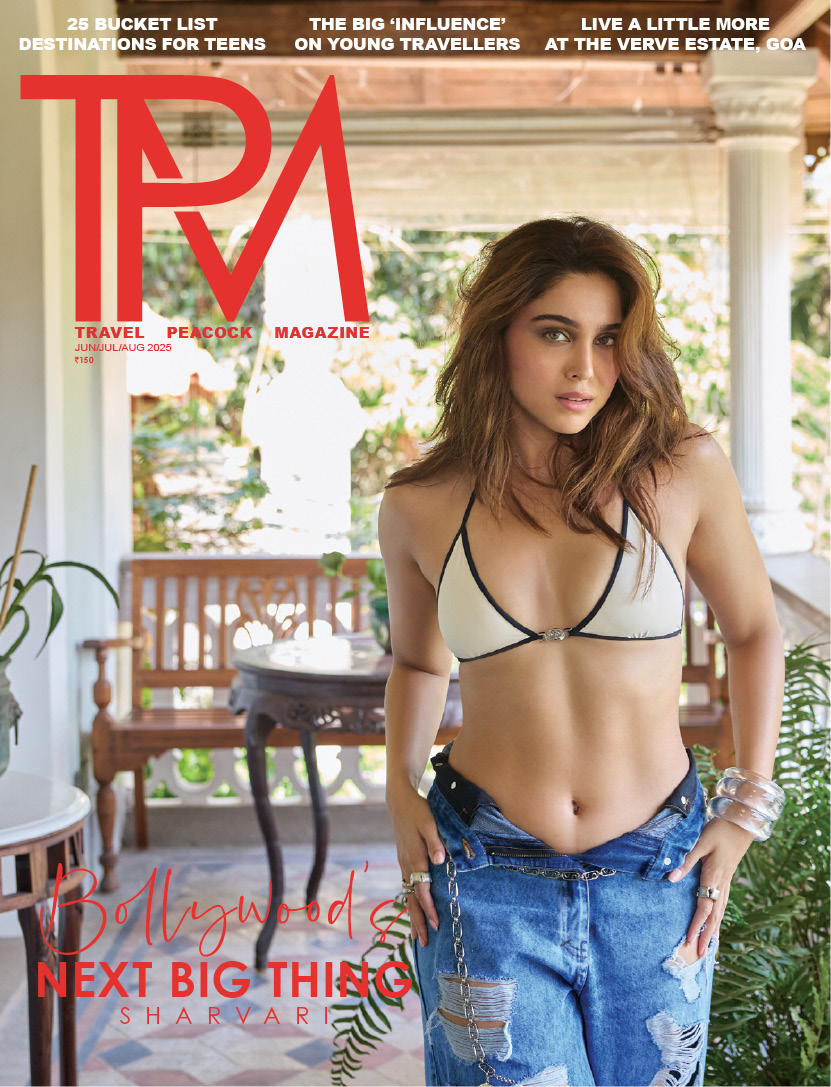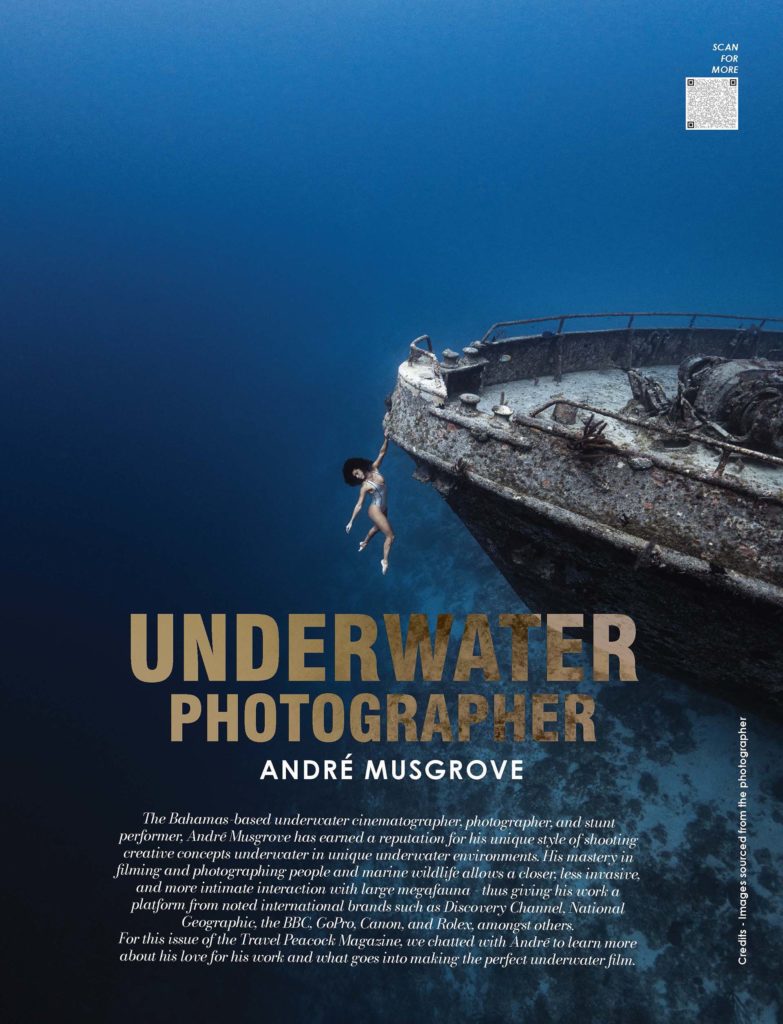
Credits – Images sourced from the photographer
The Bahamas-based underwater cinematographer, photographer, and stunt performer, André Musgrove has earned a reputation for his unique style of shooting creative concepts underwater in unique underwater environments. His mastery in filming and photographing people and marine wildlife allows a closer, less invasive, and more intimate interaction with large megafauna – thus giving his work a platform from noted international brands such as Discovery Channel, National Geographic, the BBC, GoPro, Canon, and Rolex, amongst others.
For this issue of the Travel Peacock Magazine, we chatted with André to learn more about his love for his work and what goes into making the perfect underwater film.
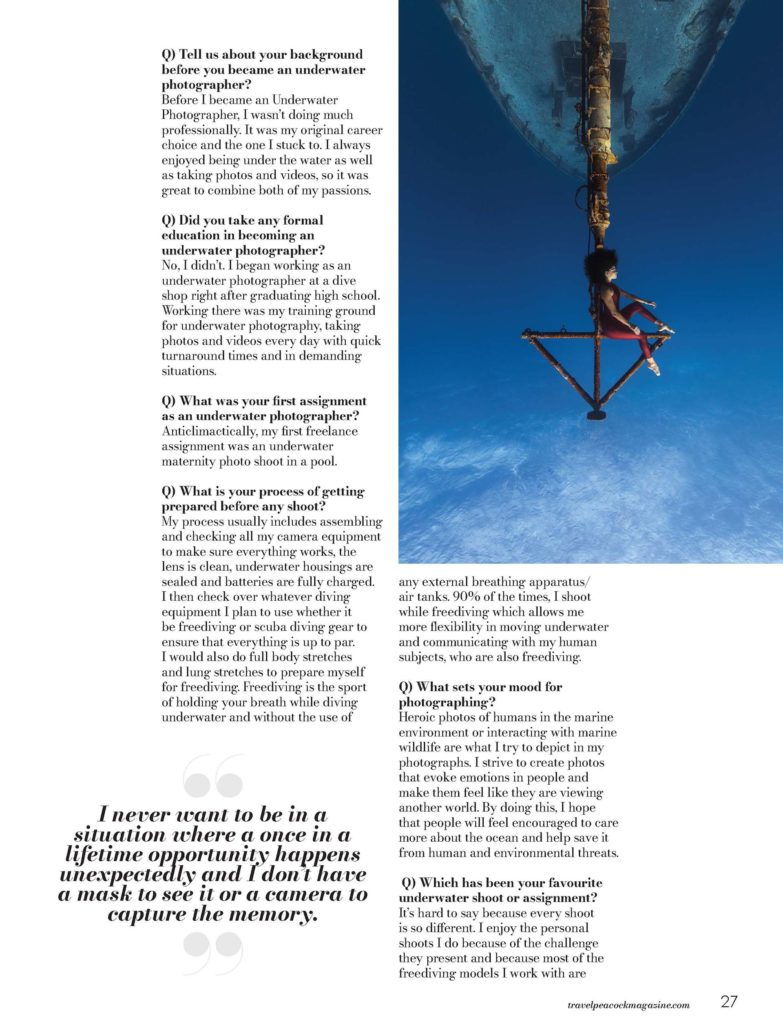
[Q] Tell us about your background before you became an underwater photographer?
Before I became an Underwater Photographer, I wasn’t doing much professionally. It was my original career choice and the one I stuck to. I always enjoyed being under the water as well as taking photos and videos, so it was great to combine both of my passions.
[Q] Did you take any formal education in becoming an underwater photographer?
No, I didn’t. I began working as an underwater photographer at a dive shop right after graduating high school. Working there was my training ground for underwater photography, taking photos and videos every day with quick turnaround times and in demanding situations.
[Q] What was your first assignment as an underwater photographer?
Anticlimactically, my first freelance assignment was an underwater maternity photo shoot in a pool.
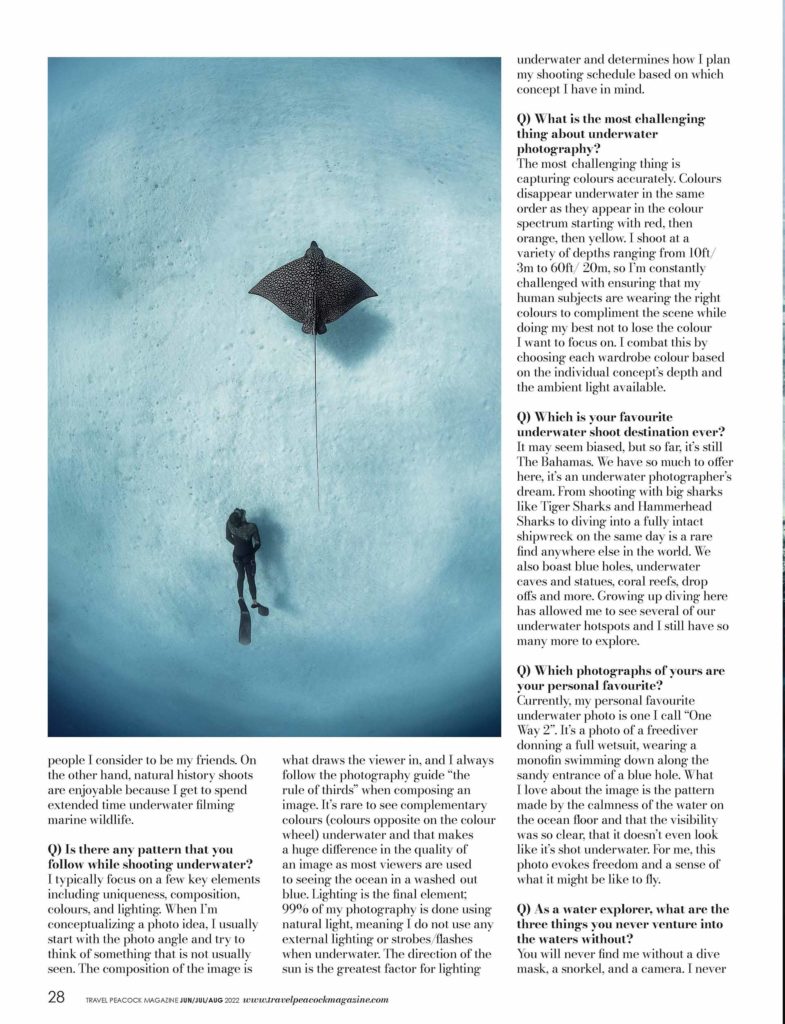
[Q] What is your process of getting prepared before any shoot?
My process usually includes assembling and checking all my camera equipment to make sure everything works, the lens is clean, underwater housings are sealed and batteries are fully charged. I then check over whatever diving equipment I plan to use whether it be freediving or scuba diving gear to ensure that everything is up to par. I would also do full body stretches and lung stretches to prepare myself for freediving. Freediving is the sport of holding your breath while diving underwater and without the use of any external breathing apparatus/air tanks. 90% of the times, I shoot while freediving which allows me more flexibility in moving underwater and communicating with my human subjects, who are also freediving.
[Q] What sets your mood for photographing?
Heroic photos of humans in the marine environment or interacting with marine wildlife are what I try to depict in my photographs. I strive to create photos that evoke emotions in people and make them feel like they are viewing another world. By doing this, I hope that people will feel encouraged to care more about the ocean and help save it from human and environmental threats.
[Q] Which has been your favourite underwater shoot or assignment?
It’s hard to say because every shoot is so different. I enjoy the personal shoots I do because of the challenge they present and because most of the freediving models I work with are people I consider to be my friends. On the other hand, natural history shoots are enjoyable because I get to spend extended time underwater filming marine wildlife.
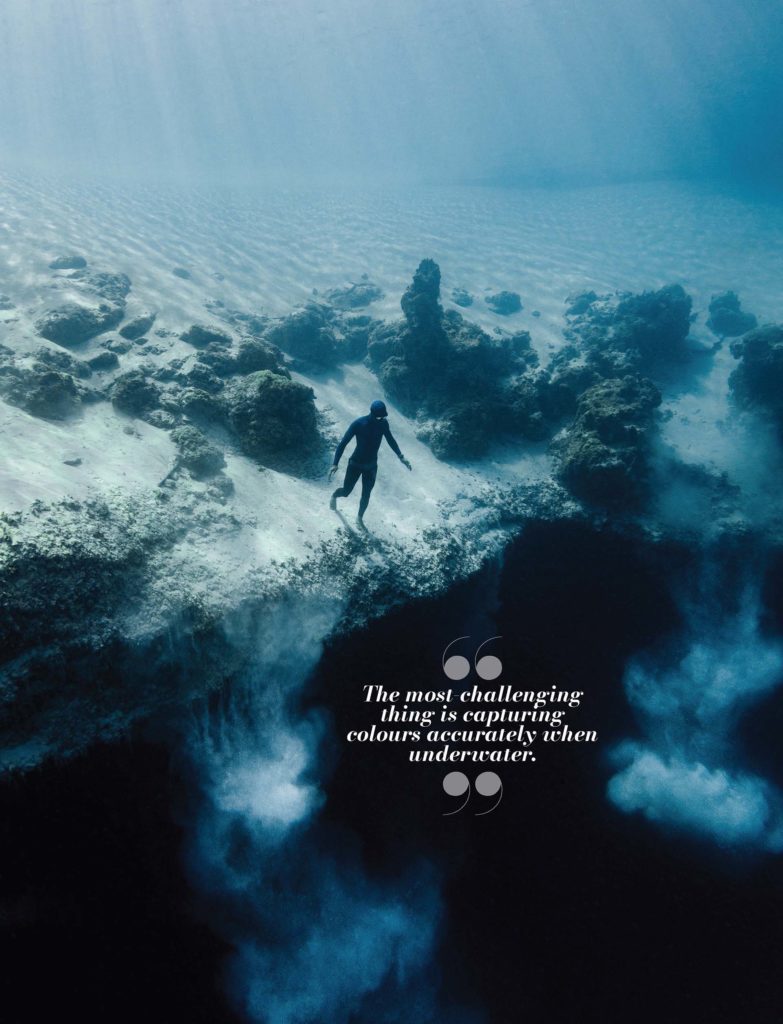
[Q] Is there any pattern that you follow while shooting underwater?
I typically focus on a few key elements including uniqueness, composition, colours, and lighting. When I’m conceptualizing a photo idea, I usually start with the photo angle and try to think of something that is not usually seen. The composition of the image is what draws the viewer in, and I always follow the photography guide “the rule of thirds” when composing an image. It’s rare to see complementary colours (colours opposite on the colour wheel) underwater and that makes a huge difference in the quality of an image as most viewers are used to seeing the ocean in a washed-out blue. Lighting is the final element; 99% of my photography is done using natural light, meaning I do not use any external lighting or strobes/flashes when underwater. The direction of the sun is the greatest factor for lighting underwater and determines how I plan my shooting schedule based on which concept I have in mind.
[Q] What is the most challenging thing about underwater photography?
The most-challenging thing is capturing colours accurately. Colours disappear underwater in the same order as they appear in the colour spectrum starting with red, then orange, then yellow. I shoot at a variety of depths ranging from 10ft/ 3m to 60ft/ 20m, so I’m constantly challenged with ensuring that my human subjects are wearing the right colours to compliment the scene while doing my best not to lose the colour I want to focus on. I combat this by choosing each wardrobe colour based on the individual concept’s depth and the ambient light available.
[Q] Which is your favourite underwater shoot destination ever?
It may seem biased, but so far, it’s still The Bahamas. We have so much to offer here, it’s an underwater photographer’s dream. From shooting with big sharks like Tiger Sharks and Hammerhead Sharks to diving into a fully intact shipwreck on the same day is a rare find anywhere else in the world. We also boast blue holes, underwater caves and statues, coral reefs, drop-offs and more. Growing up diving here has allowed me to see several of our underwater hotspots and I still have so many more to explore.
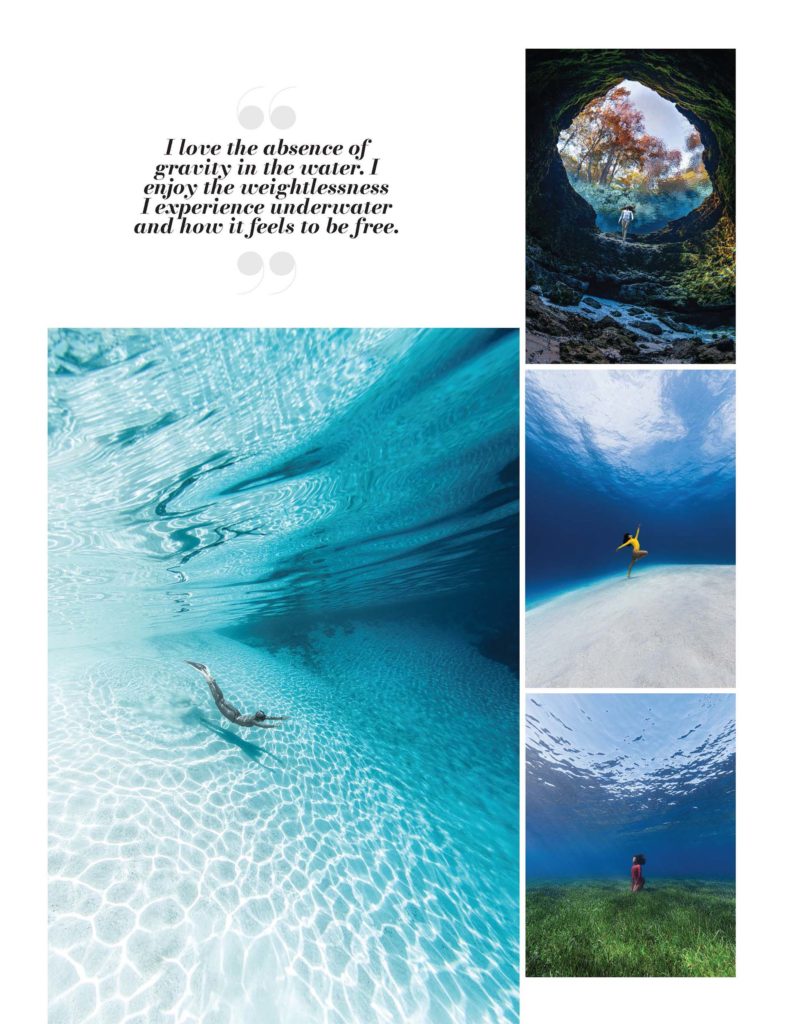
[Q] Which photographs of yours are your personal favourite?
Currently, my personal favourite underwater photo is one I call “One Way 2”. It’s a photo of a freediver donning a full wetsuit, wearing a monofin swimming down along the sandy entrance of a blue hole. What I love about the image is the pattern made by the calmness of the water on the ocean floor and that the visibility was so clear, that it doesn’t even look like it’s shot underwater. For me, this photo evokes freedom and a sense of what it might be like to fly.
[Q] As a water explorer, what are the three things you never venture into the waters without?
You will never find me without a dive mask, a snorkel, and a camera. I never want to be in a situation where a once in a lifetime opportunity happens unexpectedly and I don’t have a mask to see it or a camera to capture the memory. The snorkel is important so that I don’t have to raise my head out of the water to take a breath!
[Q] What are some of the things you are obsessed with as an underwater photographer?
I love the absence of gravity in the water. I enjoy the weightlessness I experience underwater and how it feels to be free.
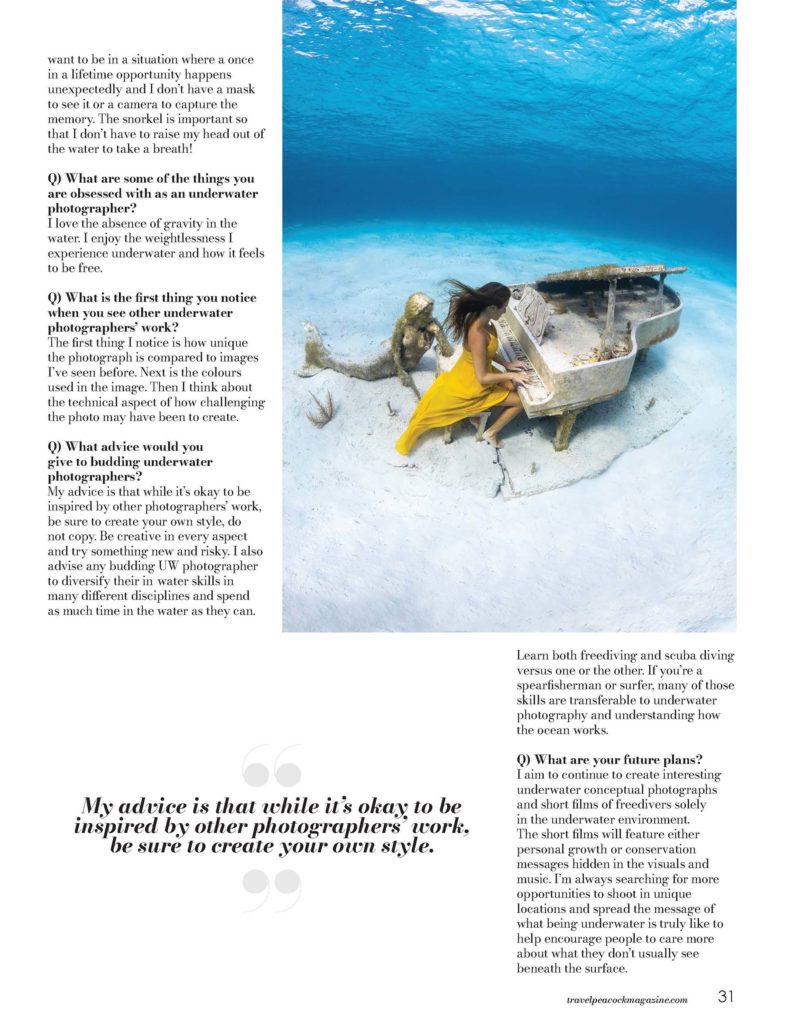
[Q] What is the first thing you notice when you see other underwater photographers’ work?
The first thing I notice is how unique the photograph is compared to images I’ve seen before. Next is the colours used in the image. Then I think about the technical aspect of how challenging the photo may have been to create.
[Q] What advice would you give to budding underwater photographers?
My advice is that while it’s okay to be inspired by other photographers’ work, be sure to create your own style, do not copy. Be creative in every aspect and try something new and risky. I also advise any budding UW photographer to diversify their in-water skills in many different disciplines and spend as much time in the water as they can. Learn both freediving and scuba diving versus one or the other. If you’re a spearfisherman or surfer, many of those skills are transferable to underwater photography and understanding how the ocean works.
[Q] What are your future plans?
I aim to continue to create interesting underwater conceptual photographs and short films of freedivers solely in the underwater environment. The short films will feature either personal growth or conservation messages hidden in the visuals and music. I’m always searching for more opportunities to shoot in unique locations and spread the message of what being underwater is truly like to help encourage people to care more about what they don’t usually see beneath the surface.

 Add to favorites
Add to favorites

